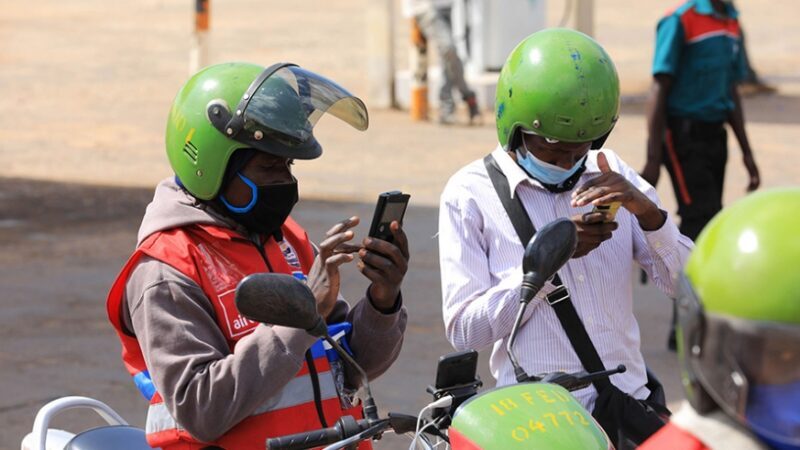The adverse effects of the Covid-19 pandemic are trickling down to major sectors of Rwanda’s economy with tourism and hospitality, aviation, retail, and manufacturing bearing the brunt of the strict measures the government has put in place.
That has essentially affected the growing digital payments, which are linked to the same sectors that were hit. But if there’s one thing to thank for 2020 is the fact that the outbreak also accelerated adoption of digital payments in many other sectors.
In any way, she adds, the pandemic highlighted the value in swift growth of volumes of transactions and value of transactions.
That is true for the most part because data shows that there was a significant increase in the uptake of digital payments.
The volume and value of transactions in mobile payments, mobile banking, and internet banking, all increased significantly during the first half of 2020 when the pandemic hit.

A passenger uses Tap&Go card to pay for transport fee as he boards a bus in Kigali. / Photo: Craish Bahizi
The volume of mobile payment increased by 51 per cent in the first half of 2020 to 503,781,913 from the previous year, while the volume of mobile banking increased by 29.1 per cent to 4,897,019.
In the same period, the volume of internet banking went up by 71.2 per cent and the value of transactions increased by 48.8 per cent to Rwf3,024 billion.
That is partly because payment system service providers offered cost incentives at the onset of the pandemic. In March, the payment industry agreed to zero charges on all transactions between bank accounts and mobile wallets.
They also agreed on zero charges on all mobile transfers, zero merchant fees on payments for all contactless point of sale transactions, and increased the limit for individual transfers.
The measures went along to incentivize people and businesses to adopt digital payments, according to the National Bank of Rwanda.
Mbabazi asserts that the outbreak highlighted that the cost of transactions has something to do with how quickly digital payments are adopted.
“When Central bank ordered zero fees and cash was discouraged, more people took up digital payments,” she notes. “The good news is merchant payments remain free for consumers, with or without the pandemic, therefore every business can and must offer digital payments.”
Still, she says there are big businesses that reject digital payments.
“There were businesses selling mask-making materials who categorically refused digital payments, demanded cash. And if you didn’t get an EBM receipt, you got a discount,” she says.
Therefore, she insists that more policy mandates and enforcement are needed.
It is not yet clear whether the positive trend that Covid has promoted is a short-lived experience or whether the momentum of accelerated digital payments are likely to continue.
Eric Rwigamba, the Director-General of the Financial Sector Development at the Ministry of Finance and Economic Planning, strongly believes that is likely to be the case through 2021.
That is because consumers have understood the value of using digital payments.
“Any rational consumer looks at two things – convenience and cost. We are not doing well with cost (of transacting), but digital avenues bring about convenience,” he notes.
The optimism is also based on the ongoing conversation to incentivize cashless payments, either through tax refunds or tax rebates both to businesses that accept digital payments and consumers that prefer digital avenues.
Other developments
The value of funds transferred via Mobile Money grew by 450 per cent between January and April this year to reach Rwf40 billion (over $ $42 million), according to data from Rwanda Utilities Regulation Authority.
This means that there was a sharp decline in the use of cash in payment of goods and services, a development that the government has been pursuing for years.
The development was among other things a result of a move by Central Bank and local telecoms to temporarily remove charges on transfers.
Analysis by Insight2Impact showed that with zero fees more people switched to mobile money transfers. With the number of unique subscribers, sending money virtually doubled from 600,000 in the week before lockdown to 1.2 million in the week after lockdown and 1.8 million people in the final week of April.
The weekly value of money spent digitally from mid-February to mid-April at merchant outlets increased 700 per cent further driving the uptake of cashless payments.
Cashless penetration is measured by aspects such as volume of transactions, usage, footprint of infrastructure such as point of sale machines, value of e-payments to Gross Domestic Product which as of October 2019 stood at 34.6 per cent.
The dominance of cash costs the government millions of dollars.
The cost of producing currency in Rwanda is estimated at $1.5 million annually while Rwandan banks spend between Rwf18 billion and Rwf20 billion annually handling cash.
Taxi-motos go digital
The pandemic pushed the government’s plan to digitalise public transport, particularly for taxi-motos.
All taxi-moto businesses were directed by the regulator to acquire metres that allow passengers to pay digitally without exchange of cash in people’s hands, a move that could have increased the uptake of cashless payment for transport.
For public buses, it has already proved that it works following the introduction of Tap&Go system. Previously, to secure a trip by bus out of the city involved making a prior trip to the bus park to book and pay a ticket.
This was time-consuming and drove up costs for passengers involved.
At the end of 2019, AC Group, a Rwandan tech firm enabling payment in public transport introduced an intervention to improve convenience through their Tap&Go intra-city solution.
The firm, which commenced digitizing payments in public transport buses in 2015, rolled out an inter-city solution at the end of 2019 to create a convenient way to book and pay for travel across the country as they do for city transport on public transport.
This allows users to book their tickets for inter-city travels from wherever they are using the Tap&Go Application.
With an estimated over 300,000 daily users of public transport in intercity routes, the system aims at improving efficiency and quality of services without driving up costs of operation.
Using the Tap&Go app, passengers do not have to make unnecessary trips to the bus park to book their tickets and can book their travels on their mobile phones from anywhere and just go when the time of departure comes.
This year, AC Group upgraded the system to taxi motos.
A passenger is now able to get information on current and upcoming trips, get on Tap&Go Ride (taxi moto), to get to the bus park and pay for all the options with one Tap&Go card.
The solution allows for consistent scheduling for every departure as well as real-time information on availability schedules per route and respective bus companies.
The solution also has options for booking a ticket online via the Tap&Go app or web as well as paying for tickets using cashless payment platforms.
Source: The New Times






